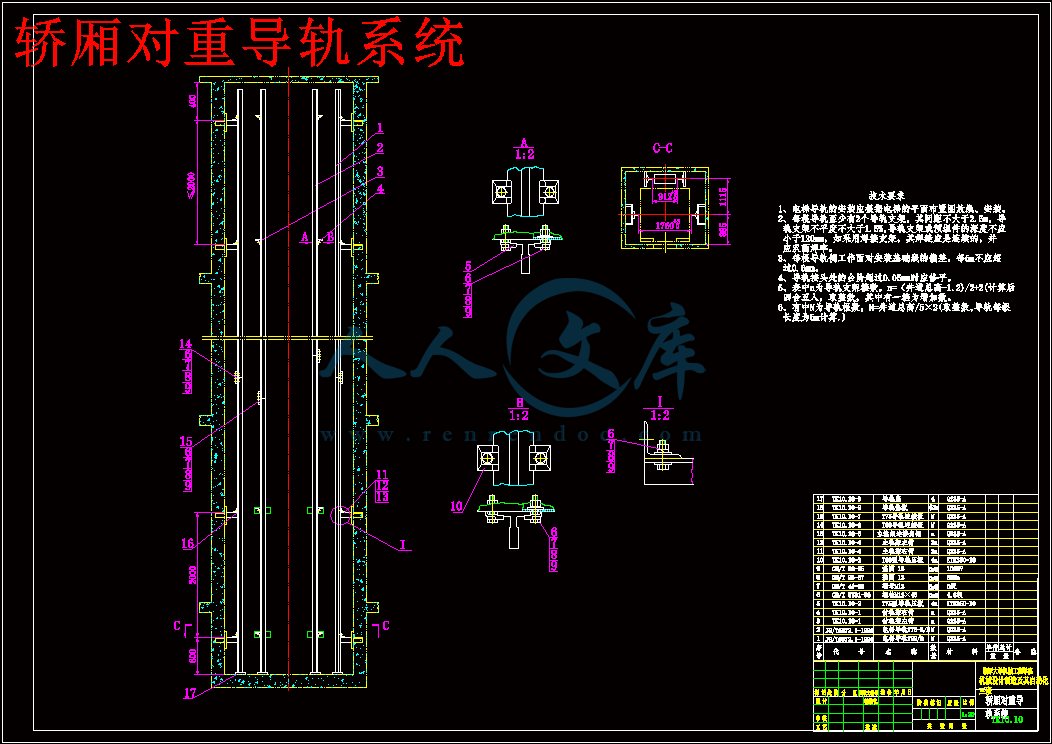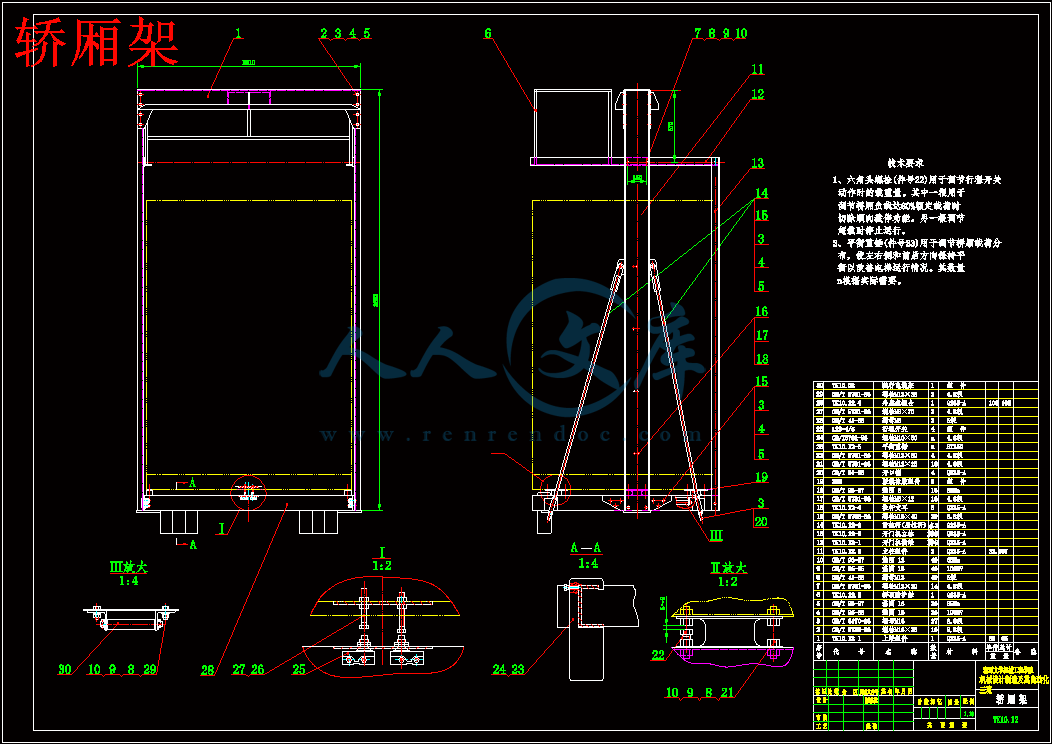交流变频调压调速电梯-轿厢结构设计
32页 12000字数+说明书+任务书+外文翻译+文献综述+9张CAD图纸【详情如下】
交流变频调压调速电梯-轿厢结构设计说明书.doc
任务书.doc
外文翻译--电梯.doc
客梯轿厢.dwg
总装配图.dwg
承重梁.dwg
文献综述.doc
最后总图.dwg
评阅表.doc
轿厢对重导轨系统.dwg
轿厢架.dwg
轿厢门组合.dwg
鉴定意见.doc
摘 要
电梯,是指动力驱动,利用刚性导轨运行的箱体或者沿固定线路运行的梯级(踏步),进行升降或者平行运送人、货物的机电设备,包括人(货)电梯、自动扶梯、自动人行道。习惯上不论其驱动方式如何,将电梯作为建筑物内垂直交通运输工具的总称。
电梯兴衰发展的根本原因在于采用了电力作为动力来源。并随着电机技术的发展,从直流电机的改进,交流异步单速,双速交流电梯,乃至生产专用的交直流电梯电机,开口电机等,显著改善了电梯的工作性能。随着控制技术的发展,特别电子技术的发展,PC机和电子计算机技术成功地应用到电梯的电气控制系统中,电梯的自动化程度,性能,可靠性,运行效果得到更为显著提高。
本文主要是对1000kg交流变频调压调速电梯(VVVF)的设计,重点涉及电梯的机械部件轿厢的设计。
关键词:运输设备;电梯;电子计算机技术;自动化
Abstract
The elevator, it is to point to driving, the use of rigid rail running casing or fixed line running along the cascade (step), to lift or parallel transporting people and goods of mechanical and electrical equipment, including people (cargo) elevators, escalators, automatic sidewalks. Regardless of the drive way, will the elevator as the floorboard of the vertical transport within the building.
Elevator the root cause of the rise and development lies in the power as a source of power. And with the development of electrical technology, from the improvement of dc motor, ac asynchronous single speed of a two-speed exchange elevator, and even in the production of special ac/dc elevator motors, opening machine, etc., significantly improve the performance of the lift. Along with the development of control technology, especially the development of electronic technology, PC and electronic computer technology successfully applied in the electric control system of the elevator, the elevator of the degree of automation, performance, reliability, operation effect get more improved significantly.
This article mainly to 1000 kg of ac variable frequency regulating speed control (VVVF) elevator design, focusing on the design of mechanical parts capsules of the lift.
Key words : transportation equipment; elevator;computer technology; automation
目 录
文献综述 ……………………………………………………………………… 3
第一章 绪论……………………………………………………………………5
1.1 课题的目的和意义……………………………………………………… 5
1.2 电梯的分类……………………………………………………………… 5
1.3 电梯类型的选择以及设计介绍………………………………………… 5
曳引系统…………………………………………………………… 7
2.1 曳引机的优点……………………………………………………………7
2.2 曳引机的分类…………………………………………………………… 8
2.3 曳引机的选择…………………………………………………………… 8
轿厢结构设计………………………………………………………10
3.1 轿厢综述…………………………………………………………………10
3.2 轿厢架……………………………………………………………………11
3.3 轿厢体……………………………………………………………………13
3.4 轿厢与曳引钢丝绳的连接方法…………………………………………14
3.5 电梯门系统………………………………………………………………15
3.6 电梯导向系统……………………………………………………………18
3.7 轿厢的超载装置…………………………………………………………19
3.8 轿厢面积…………………………………………………………………21
轿厢结构计算………………………………………………………23
4.1 主要技术性能参数………………………………………………………23
4.2 轿厢架相关计算…………………………………………………………23
4.3 承重梁的计算……………………………………………………………27
4.4 导轨弯曲应力计算………………………………………………………30
总结………………………………………………………………………………31
参考文献…………………………………………………………………………31
三、电梯发展方向
随着世界科技的飞速发展,电梯产品和服务的发展更加体贴用户。
1 电梯群控系统将更加智能化 电梯智能群控系统将基于更强大群控资源。这些群控系统能够适应电梯交通中的不确定性、控制目标的多样化以及非线性表现等动态特性。 2 超高速电梯越来越快 21世纪多用途、全功能的塔式建筑高速发展,超高速电梯将越来越热门。对曳引式超高速电梯将继续在使用超大容量电动机、减振技术、高性能的微处理器、永磁同步电动机、新式滚轮导靴和安全钳、轿厢气压缓解以及噪声抑制系统等这些方向进行研究。而且采用直线电机驱动的电梯也会有较大的研究前景。我们有理由相信未来的超高速电梯舒适感会有明显提升。 3 蓝牙技术在电梯上的大量应用 蓝牙(Bluetooth)技术是一种全球开放的、短距无线通讯技术规范,不需要纵横交错的电缆线,便可以实现无线组网。这种技术的运用会对电梯的安装周期与费用的减少产生重要的作用,它还将提高电梯的控制精度以及可靠性以及更好解决电气设备之间的兼容性问题,也有利于把电梯更加智能归纳到大楼管理系统与管理小区系统中来。 4 绿色电梯将广泛普及 要求电梯具备节能、电磁兼容性强、少油污染、噪声低、寿命长、装潢材料绿色健康、与建筑物协调等特点。 5 电梯产业将实现网络化、信息化 、智能化 未来的电梯控制系统将会与网络技术相互结合,运用网络把各个地方的电梯集中监管起来进行维修保养;通过电梯交易网站进行网上贸易,包括电梯的配置、招投标等等,也可以实现在网上申请电梯的定期检查。 1.1 课题的目的和意义
电梯的发展经历了从简单到复杂的过程。可靠性不强,高故障率,维修很困难等是原始电梯最大缺点,远远不能满足现代社会生产、生活的需要。在20世纪80年代前期至90年代初,据有关资料统计,在所有交通工具中,电梯故障率居首位,随着科学技术的发展,这一切都己成为过去,现代电梯应用先进技术,大幅提高其运行平稳性及乘坐舒适感,使故障得到有限控制。
电梯轿厢系统从最初的简陋到现在的功能齐全、装饰豪华,已经经历过了一个非常大的技术跃进,产品也己固定成型,而且性能相当稳定,然而这并不能满足用户对电梯不断增长的需求。现今用户对电梯的舒适性、安全性等追求越来越高,于是便对电梯智能化运行也提出了更高的要求。
1.2 电梯的分类
1?按用途分类?
可分为乘客电梯,载货电梯,医用电梯等。
2?按驱动方式分类?
可分为交流电梯,直流电梯,液压电梯等。
3?按速度分类
可分为低速电梯(常指低于1.00m/s速度的电梯),中速电梯(常指速度在1.00~2.00m/s的电梯),高速电梯(常指速度大于2.00m/s的电梯)以及超高速电梯(速度超过5.00m/s的电梯)。??????
4?按电梯有无司机分类
可分为有司机电梯,无司机电梯等。?
5?按操纵控制方式分类
可分为手柄开关操纵电梯,按钮控制电梯,信号控制电梯等。?
6 特殊电梯
如斜行电梯,立体停车场用电梯以及建筑施工电梯。
1.3 电梯类型的选择以及设计介绍
1.3.1电梯类别的选择
根据课题的要求,我们可以确定此次设计的电梯为乘客电梯,因此必须有完善的安全装置;使用交流异步电动机曳引驱动,所以属于交流电梯;又因为其额定的速度为1.6m/s,根据有齿轮曳引机和无齿轮曳引机特点的分析很容易知道,有齿轮曳引机更适合用在这次设计的电梯中;客梯只需乘客自己操作,非常简便,因此属于无司机电梯;根据其额定速度为1.6m/s,又可知其为中速电梯。总的来说此次设计的电梯属于交流中速客梯。
1.3.2电梯的设计介绍
本人的毕业设计主要内容是电梯的轿厢部分,包括电梯轿厢结构的设计(如:轿厢门系统、轿厢架的选择、轿厢的超载装置等);以及相关设计的验算(如:轿厢架上、下梁,承重梁等的验算);还有导向系统的设计等。 曳引系统
当今世界上电梯产业广泛采取运用的提升形式是曳引式提升机构。
输出和传递动力是曳引系统主要的功能,从而使电梯运行。曳引系统主要是由曳引机、曳引钢丝绳,导向轮以及反绳轮这几部分组成的。
曳引钢丝绳的作用原理是通过曳引轮一端与轿厢连接,另外一端则与对重装置连接,让井道中的轿厢和对重能够各自沿着井道中的导轨自由运行并且不发生蹭撞,在曳引机上通常放置一个导向轮使他们分开。轿厢与对重装置的重力使得曳引钢丝绳与曳引轮槽产生摩擦力。于是电动机转动带动着曳引轮转动,驱动着钢丝绳,使轿厢和对重作相对运动。从而实现轿厢在井道中沿导轨上、下往复运行以及电梯执行垂直运送任务。如图(2-1)所示:2.2 曳引机的分类
一.按照减速方式分类
1.有齿轮曳引机:动力是通过中间减速器传递至曳引轮上的曳引机,其减速箱通常采用的是蜗轮蜗杆传动(也有使用斜齿轮传动),这种曳引机使用的电动机既有交流的,也有直流的,一般运用在低速的电梯上。曳引比一般为35:2。要是电动机动力是通过减速箱从而传送至曳引轮上,这种曳引机则被称为有齿轮曳引机,一般运用在速度为2.5m/s以下的低中速电梯当中。
2.无齿轮曳引机:动力不需要用中间的减速器而是直接传递至曳引轮上的曳引机。这种曳引机以前大多运用的是直流电动机作为动力,当今国内已研发出的交流永磁同步无齿轮曳引机。其曳引比一般是2:1或者是1:1。通常载重320kg~2000kg,电梯速度大致为0.3m/s~4.00m/s。如果动力并不通过减速箱而是直接传动至曳引轮上就被称为无齿轮曳引机,一般运用在速度为2.5m/s以上的电梯当中。
3.柔性传动机构曳引机
二.按照驱动电动机分类
1.直流曳引机 可分为直流有齿曳引机以及直流无齿曳引机两类。
2.交流曳引机 可分为交流有齿曳引机、交流无齿曳引机和永磁曳引机三类。
三.按照用途分类
可分为双速客货电梯曳引机,,VVVF客梯曳引机等。
四.按照速度高低分类
可分为四类:低速度曳引机 (ν<1米/秒),中速曳引机(快速曳引机)(ν=1米/秒~2米/秒),高速曳引机(ν=2米/秒~5米/秒)以及超高速曳引机(ν>5米/秒)。
五.按照结构形式分类
分为卧式和立式曳引机。
2.3 曳引机的选择
此次电梯设计的额定速度为1.6m/s,则需要有变速器的曳引机,即用有齿轮曳引机。常用的曳引比为1:1绕法的有齿轮传动应用非常广泛,运用一般的交流客梯和载重小的货梯。1:1的曳引比是指曳引钢丝绳的速度与轿厢的速度比为1:1。这种传动结构比较简单,详见传动简图,如图(2-2)所示。
电梯起动加速度和制动减速度:a≤0.9m/s2
钢丝绳与绳轮间摩擦系数:μ=0.09
钢丝绳许用安全系数:[S]=12
钢丝绳总重量:W4=230kg
曳引传动总效率:η=0.68
经过几个月的努力我的毕业设计终于完成了,但是现在回想起来做毕业设计的整个过程,颇有心得,其中有苦也有甜,艰辛同时又充满乐趣,不过乐趣尽在其中!通过本次毕业设计,没有接受任务以前觉得毕业设计只是对这几年来所学知识的单纯总结,但是通过这次做毕业设计发现毕业设计不仅是对前面所学知识的一种检验,而且也是对自己能力的一种提高。通过这次毕业设计使我明白了自己原来知识还比较欠缺。自己要学习的东西还太多,以前老是觉得自己什么东西都会,什么东西都懂,有点眼高手低。通过这次毕业设计,我才明白学习是一个长期积累的过程,在以后的工作、生活中都应该不断的学习,努力提高自己知识和综合素质。
在此要感谢我的指导老师对我悉心的指导,感谢老师给我的帮助。在设计过程中,我通过查阅大量有关资料,与同学交流经验和自学,并向老师请教等方式,使自己学到了不少知识,也经历了不少艰辛,但收获同样巨大。在整个设计中我懂得了许多东西,也培养了我独立工作的能力,树立了对自己工作能力的信心,相信会对今后的学习工作生活有非常重要的影响。而且大大提高了动手的能力,使我充分体会到了在创造过程中探索的艰难和成功时的喜悦。虽然这个设计做的也不太好,但是在设计过程中所学到的东西是这次毕业设计的最大收获和财富,使我终身受益。
参考文献资料:
[1] 李秧耕 .电梯基本原理及安装维修全书 .北京:机械工业出版社,2001.
[2] 李惠升 .电梯控制技术 .北京:机械工业出版社,2003.
[3] 孙克军 .电梯实用技术问答.北京:机械工业出版社,2006.
[4] 朱德文 .电梯安全技术 .北京;中国电力出版社,2007.
[5] 沈鸿 .机械工程手册.北京:机械工业出版社,1982.
[6] GB7588《电梯制造与安装安全规范》.
[7] GB/T10058《电梯技术条件》.
[8] GB/T7025《电梯主参数及轿厢、井道、机房的型式与尺寸》.
[9] GB/T13435《电梯曳引机》







 川公网安备: 51019002004831号
川公网安备: 51019002004831号